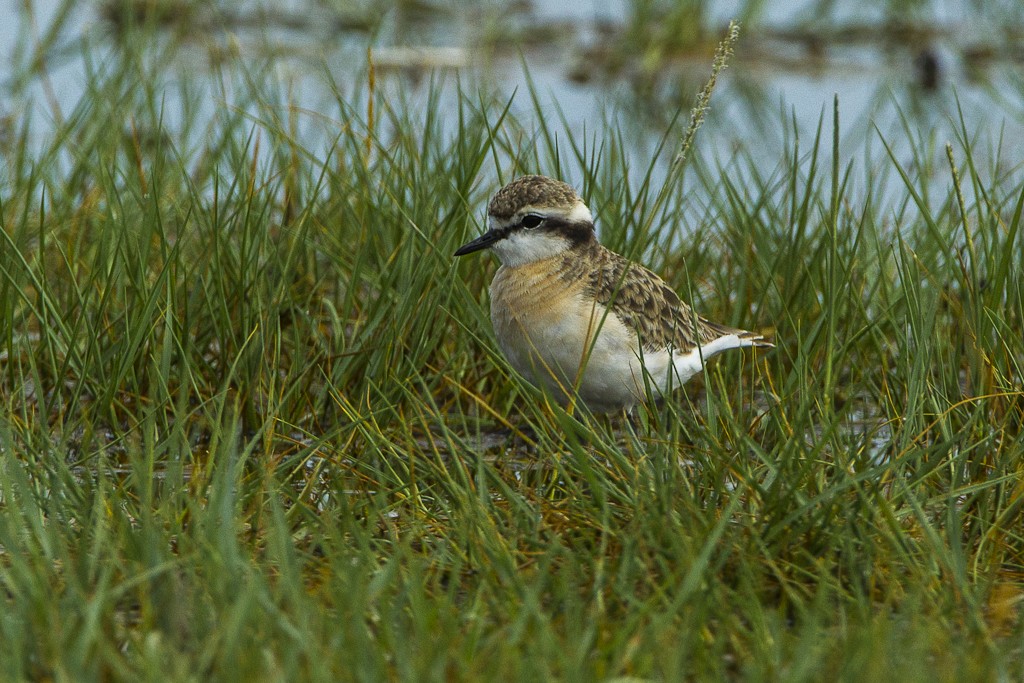Kittlitz's Plover
A species of Typical plovers Scientific name : Charadrius pecuarius Genus : Typical plovers
Kittlitz's Plover, A species of Typical plovers
Botanical name: Charadrius pecuarius
Genus: Typical plovers
Content
Description General Info
 Photo By Francesco Veronesi , used under CC-BY-SA-2.0 /Cropped and compressed from original
Photo By Francesco Veronesi , used under CC-BY-SA-2.0 /Cropped and compressed from original Description
Kittlitz's plover is a small shorebird weighing between 35-40 grams. Both male and female have a black bill, dark brown eyes with black eyelids and black legs, although sometimes the legs can appear greenish or grey. During the breeding season, the male has a white forehead, a blackish bar followed by a narrow white bar on the forecrown, whereas the rest of the crown is brown with sandy tips to the feathers. A black stripe - separated from the crown by a white superciliary stripe - runs from the bill through the eye and extends to the side of the neck forming a collar across the upper mantle. The mantle is dark grey-brown, the other upperparts are sooty brown with feathers having sandy rufous margins. The face, the chin and the upper throat are white and the rest of the underparts are yellowish, the belly is pale. Kittlitz's Plover has blackish central tail feathers that get continuously lighter towards the side of the tail; the outer one or two pairs are completely white. The female plumage is similar to the male's, only the black band across the forecrown is narrower. The non-breeding plumage does not differ much from the breeding one, the eye stripe is browner, the frontal bar is missing and the underparts are a lot paler. In general, adult wing length lies between 100–110 mm, adult bill length between 15–23 mm and adult tarsus length between 26–33 mm. Juvenile Kittlitz's plovers appear similar to adults, however the black face marks are lacking, the upperparts are brown, the hindneck collar is buff and the underparts are white. 
Size
14 cm
Nest Placement
Ground
Feeding Habits
Kittlitz's Plover employs a run-stop-search technique and foot-trembling for foraging, feeding on beetles, larvae, spiders, crustaceans, molluscs, and occasionally large crickets. Aggressive when foraging, kittlitz's Plover feeds day and night, often in small groups, showing heightened aggression before breeding season.
Habitat
Kittlitz's Plover's habitat includes flat, open areas with limited vegetation, often near water sources like lakes and rivers, and collectively within inland and coastal zones. Habitats range from grasslands and mudflats to saltmarshes and dry riverbeds. The species prefers ground-level habitats up to 2730 meters and seasonally shifts to estuaries.
Dite type
Insectivorous
General Info
Feeding Habits
Bird food type
Behavior
The species is social in the non-breeding season and stays in small flocks of about 20 individuals, however it has also been reported in larger flocks of 100-300 individuals during migratory movements. 
Distribution Area
Kittlitz's plover is distributed throughout most of sub-Saharan Africa, but is also native to Madagascar and the Nile River Delta. A genetic study reported genetic differentiation between Madagascar and the mainland population. It is common in South Africa, however rarer in arid regions of Botswana and Namibia. In Namibia, it mostly inhabits coastal regions, highlands and Ovamboland. It is more scarce in the southern lowveld of South Africa and patchy in the interior of KwaZulu-Natal and the eastern Cape. Usually it avoids mountains or densely wooded areas. The Malagasy population might result from a relatively recent immigration from mainland Africa, whereas the Madagascar plover (Charadrius thoracius) might have evolved from an earlier Kittlitz's plover population. The two species are clearly distinct and can not interbreed. Birds from Madagascar are in general smaller than birds from continental Africa. Kittlitz's plovers are heavier and have longer wings in South Africa compared to Madagascar, whereas Egyptian specimens have longer wings and shorter tarsi than in Madagascar. However, they are still regarded as the same species in the absence of apparent plumage difference. In Madagascar, Kittlitz's plover is both a breeding resident and intra-island migrant and has been recorded mostly below 950 m, although it has been recorded at up to 1,400 m too. 
Species Status
Not globally threatened.
Scientific Classification
Phylum
Chordates Class
Birds Order
Shorebirds Family
Plovers Genus
Typical plovers Species
Kittlitz's Plover